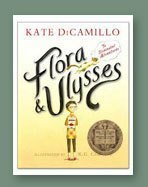The Beginnings of Two Books: FLORA AND ULYSSES and CHARLOTTE’S WEB
When I began writing for children, I was pretty vague about the possible prizes. I knew some books had shiny stickers, but not that every January carefully-chosen groups of librarians gathered in secret to choose the year’s most distinguished novel for children. More recently, I learn on facebook the day when the Newbery and other ALA awards will be chosen, and go back there as friends report the prizes as they’re announced. Hearing that Kate DiCamillo won the Newbery for FLORA AND ULYSSES, I headed to my local library just after it opened. I remembered seeing the book on display, and could snatch it before requests started flowing in.
I also read an interview and learned about how Kate started the novel after seeing a dead squirrel on the sidewalk and, frequently, a vacuum cleaner that had ended up in her garage, still ridden with cat hair, to which she’s allergic, after her mother died. I see these on the first pages, though the squirrel remains alive, and soon will be writing poetry, after a hazardous encounter with a rambunctious vacuum cleaner. Kate DiCamillo also mentioned that she was inspired by reading E.B. White’s essay, “The Death of a Pig,” which led to the novel that won a Newbury Honor in 1952.
I’ll get back to her novel, but turned to CHARLOTTE’S WEB, which my UMass class was just about to adore and gently pick apart, as is our English Department duty. A student remarked on how Charlotte was a writer not only as she drew silk to form the letters in her web, but through her whole way of being: taking time to muse and reflect, moving between single words, each weighed, and her larger goal. She sometimes seemed to others not to be doing much as she sat high in the beams of the barn, where she had such a good view, but she was. It’s just the third day of class, but I already adore my students.
Critics have mentioned how E.B. White’s three books for children all circle around a character with something that makes him not quite fit in: Wilbur is a runt who’s almost killed for that, Stuart Little is a two-inch-tall boy who looks like a mouse, and Louis is a trumpeter swan who can’t speak. They’re all boys, but from what we know about E.B. White, he was more like Charlotte and Fern Arable when she sat on a stool in the barn and listened to the animals then he was like anyone else in the book. As a shy boy, he was at happiest sitting silently among soft-breathing horses in a stable, and while he worked in New York City as a young man, he was glad to buy a farm in Maine and settle there. He didn’t like crowds and kept a distance from awards, which he spoofs in this novel. At his funeral, his stepson said, “If Andy could have been here, he wouldn’t have been here.”
E.B. White took his time, saying that he started STUART LITTLE for his six year old niece, finishing it up when she was in college and reading Hemingway. The quiet places where he found inspiration, and a kind of holiness. He said, “When you enter a barn cellar, raise your hat.” And he gave us that barn where a true friendship is made and a writer does her life’s work.
Kate DiCamillo said that after getting the early morning phone call with librarians on speaker phones telling her that the novel she wrote had won the Newbery Award, she didn’t know what else to do, so she sat down and wrote. I think E.B. White would like that.







